In today’s digital landscape, curated content has emerged as a vital component of successful email marketing strategies. By carefully selecting and sharing relevant, high-quality content from various sources, businesses can engage their audience, establish thought leadership, and drive growth. This comprehensive guide explores the power of curated content in email marketing, unveils five hidden gem strategies to enhance your efforts, and highlights how Prism Reach, an innovative AI-powered SaaS solution, can elevate your content curation and personalization endeavors.
Key Facts and Statistics
Understanding the impact of curated content on email marketing is supported by compelling statistics:
- Audience Engagement: Curated content can increase email engagement rates by up to 30%.
- Time Efficiency: Marketers spend an average of 20% less time on content creation by leveraging curation strategies.
- Trust Building: 70% of consumers feel more connected to brands that provide valuable, curated content.
- SEO Benefits: Curated content can improve website SEO by increasing time spent on site and reducing bounce rates.
- Lead Generation: Gated curated content, such as eBooks and whitepapers, can boost lead generation by 50%.
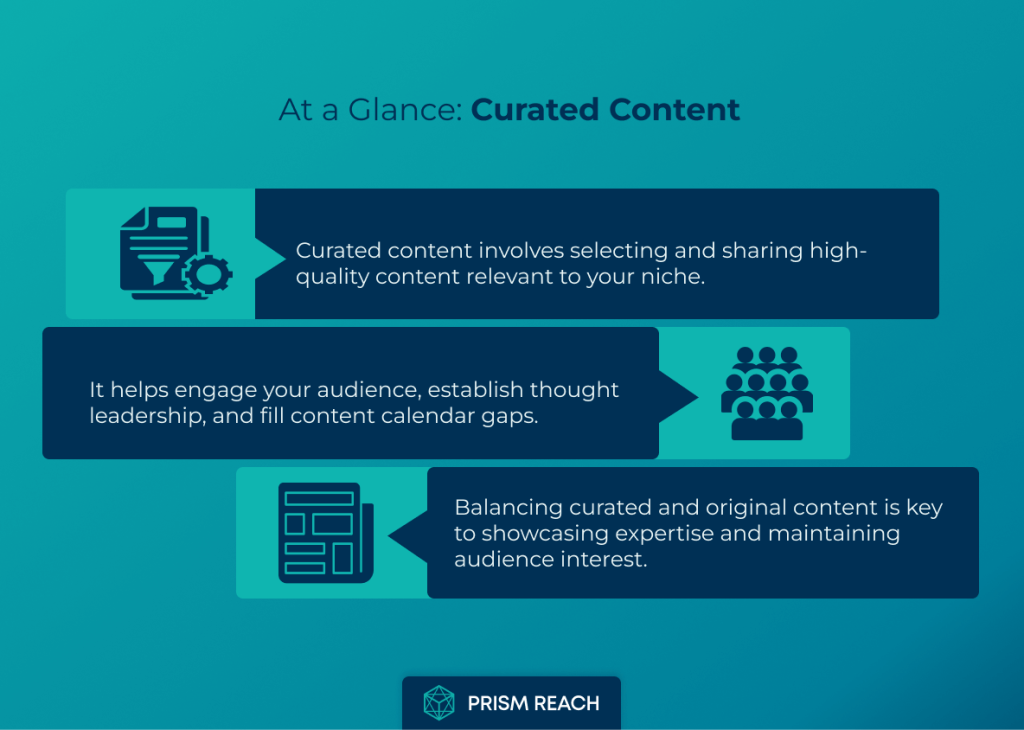
Understanding Curated Content
What is Curated Content?
At its core, curated content involves handpicking and sharing the best content related to your niche or industry. This can include articles, videos, infographics, social media posts, and more. The key is to select content that aligns with your brand’s values, resonates with your target audience, and provides genuine value.
Curated content serves multiple purposes. It keeps your audience informed about the latest trends, insights, and best practices in your industry. It also saves them time by filtering out the noise and delivering only the most relevant and valuable information. By consistently sharing high-quality curated content, you position yourself as a trusted resource and thought leader in your field.
Moreover, curated content can help fill gaps in your content calendar and supplement your original content creation efforts. It allows you to maintain a consistent publishing schedule without the pressure of constantly producing new content from scratch. This is particularly useful for small teams or businesses with limited resources.
However, it’s important to note that curated content should not replace original content entirely. While curation can enhance your content mix, it’s still crucial to create unique, brand-specific content that showcases your expertise and sets you apart from competitors. The key is to find the right balance between curated and original content based on your goals, resources, and audience preferences.
Does the Quality of Curated Content Matter?
Absolutely! The quality of the content you curate directly reflects on your brand’s reputation. Sharing low-quality, irrelevant, or outdated content can erode trust and disengage your audience. On the other hand, consistently curating high-quality, insightful content positions you as a reliable source of information and strengthens your brand’s authority.
When selecting content to curate, it’s essential to be discerning. Look for content that is well-researched, well-written, and provides unique insights or perspectives. Avoid content that is overly promotional, biased, or lacking in substance. Take the time to read through each piece thoroughly to ensure it meets your quality standards and aligns with your brand’s values.
It’s also important to consider the credibility and reputation of the sources you curate from. Sharing content from respected industry publications, thought leaders, and experts can lend credibility to your own brand. On the flip side, curating content from questionable or unreliable sources can damage your reputation and undermine your audience’s trust.
Upgrade Your Email Marketing with AI Personalization!
Comparison: Curated Content
1. Curated Content
- Advantages:
- Saves time and resources by repurposing existing material.
- Enhances brand credibility and thought leadership by showcasing authoritative sources.
- Fills content calendar gaps and drives audience engagement.
- Disadvantages:
- Can lack originality, risking a diluted brand voice.
- Over-reliance on external sources may reduce the uniqueness of your content.
2. Original Content
- Advantages:
- Showcases a unique brand voice and proprietary expertise.
- Builds direct audience trust and supports brand differentiation.
- Enhances SEO through unique keywords and fresh perspectives.
- Disadvantages:
- Typically involves higher creation costs.
- Can be time-consuming to produce consistently.
3. Balanced Content Mix
- Advantages:
- Optimizes content variety to keep the audience engaged.
- Efficiently utilizes resources by blending both curated and original content.
- Enhances overall content strategy flexibility.
- Disadvantages:
- Requires careful planning to maintain a consistent tone.
- Balancing the mix can be challenging if not strategically managed.
4. Data-Driven Content Curation
- Advantages:
- Improves content relevance and personalization by leveraging analytics.
- Provides actionable insights and tracks performance metrics.
- Increases audience engagement with tailored content.
- Disadvantages:
- Demands strong data analysis skills.
- Raises potential privacy concerns regarding data collection.
5. Content Aggregation Tools
- Advantages:
- Streamlines the discovery process by pulling content from diverse sources.
- Saves research time and provides up-to-date information.
- Simplifies content organization with centralized tools.
- Disadvantages:
- May miss out on niche or highly specialized sources.
- Can lead to information overload if not curated carefully.
6. Social Media Content Curation
- Advantages:
- Expands audience reach and increases content visibility.
- Encourages social sharing and drives traffic back to your site.
- Builds community engagement through interactive platforms.
- Disadvantages:
- Depends on algorithmic factors that may affect consistency.
- Requires constant monitoring to maintain relevancy and engagement.
7. Niche Content Curation
- Advantages:
- Targets specific audiences, establishing niche authority.
- Enhances content relevance for a specialized market.
- Increases audience loyalty by focusing on industry-specific topics.
- Disadvantages:
- Limited audience size may restrict reach.
- Requires deep industry knowledge to effectively curate content.
8. Automated Content Curation
- Advantages:
- Saves time and reduces manual workload by automating updates.
- Ensures regular content updates and consistency at scale.
- Provides scalable solutions for managing large volumes of content.
- Disadvantages:
- May lack personalization, leading to irrelevant content at times.
- Risk of automating content that doesn’t fully align with your brand voice.
This comparison highlights that while each strategy offers unique benefits—from cost efficiency and enhanced engagement to brand differentiation and scalability—they also come with challenges that require thoughtful planning and continuous oversight to ensure that content remains relevant, personalized, and true to your brand identity.
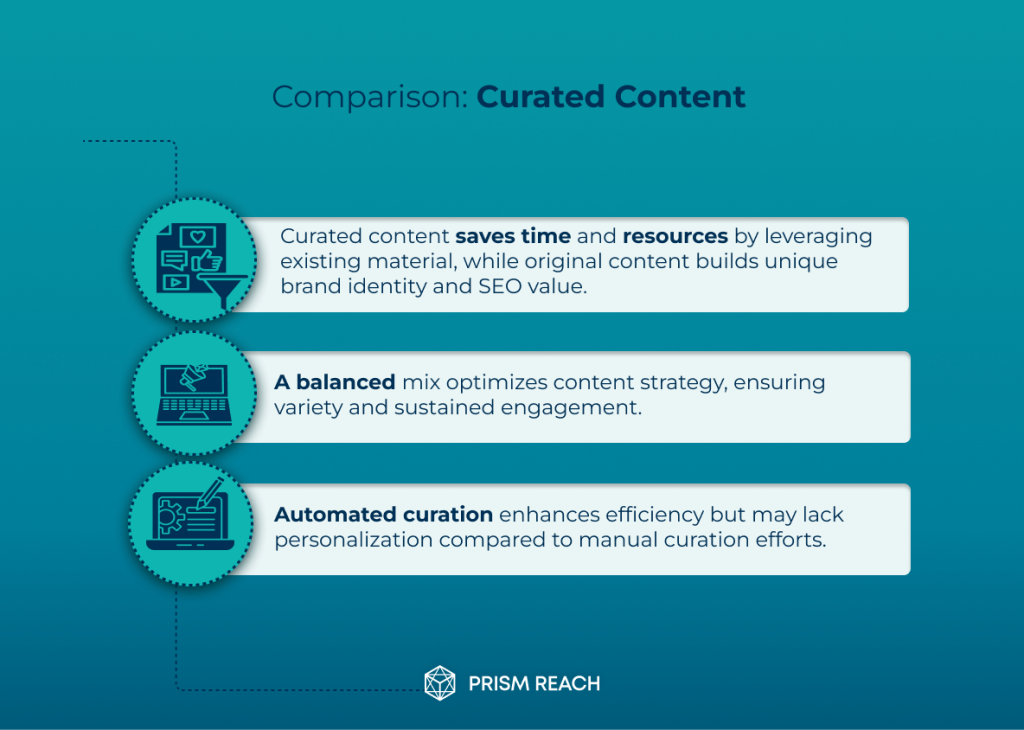
5 Hidden Gem Strategies to Enhance Curated Content
Maximizing the impact of curated content requires innovative strategies that go beyond conventional approaches. Here are five hidden gem strategies that can significantly enhance your content marketing efforts:
Create a Curated Content Hub
Strategy: Develop a dedicated section on your website or blog that serves as a hub for curated content around specific topics relevant to your audience.
- Effectiveness: High; it positions your brand as a go-to resource for valuable information, improving SEO and user engagement.
- Obscurity: Many brands focus on individual posts rather than creating a comprehensive resource center.
- Ease of Implementation: Requires some initial setup but can be maintained easily with regular updates.
- Uniqueness: This approach consolidates valuable resources in one place, making it easy for users to find curated content.
Example: A technology blog creates a curated content hub that aggregates the latest AI developments, industry reports, and expert opinions. Using Prism Reach, the hub is continuously updated with relevant content, ensuring visitors have access to the most current and valuable information in one centralized location.
Use AI Tools for Curation
Strategy: Leverage AI-driven content curation tools (like Feedly or Curata) to automate the discovery and aggregation of relevant articles, videos, and resources.
- Effectiveness: High; AI tools can save time and ensure you’re consistently sharing fresh, relevant content.
- Obscurity: While many use AI for content creation, its application in curation is less common.
- Ease of Implementation: Most AI tools are user-friendly and can be integrated into existing workflows.
- Uniqueness: This strategy allows for continuous curation without the manual effort typically involved.
Example: A marketing agency utilizes Prism Reach’s AI-driven curation capabilities to automatically gather and organize the latest digital marketing trends and insights. This ensures that their newsletters are always packed with up-to-date and relevant content, enhancing their value proposition to subscribers.
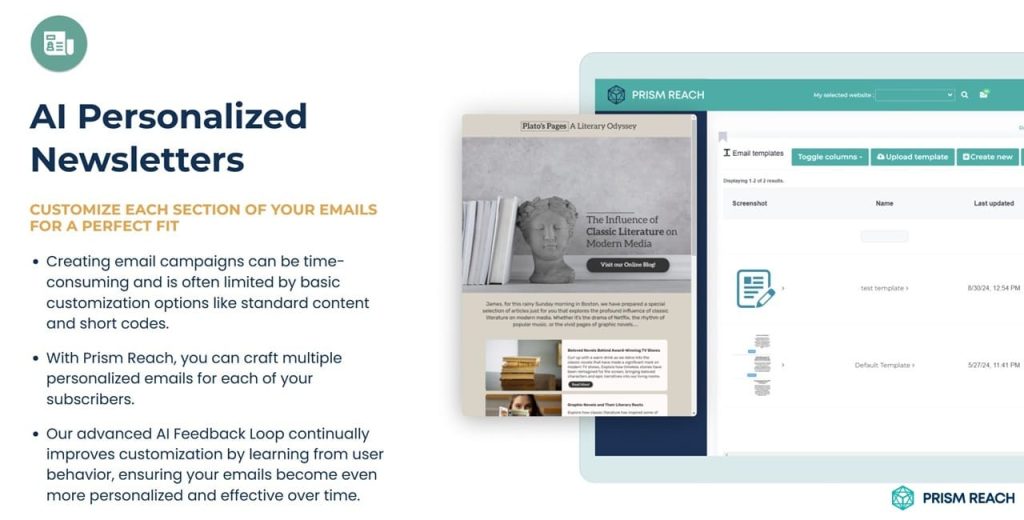
Curate User-Generated Content (UGC)
Strategy: Actively solicit and curate content created by your audience, such as testimonials, reviews, or social media posts.
- Effectiveness: High; UGC fosters community engagement and builds trust among potential customers.
- Obscurity: Many brands overlook the potential of UGC in their content strategies.
- Ease of Implementation: Requires a clear call-to-action and possibly incentives for users to share their content.
- Uniqueness: This approach not only provides fresh content but also strengthens customer relationships.
Example: An online fitness platform curates workout videos and success stories submitted by their users. Using Prism Reach, these UGC pieces are featured in their email newsletters, showcasing real-life results and fostering a sense of community among subscribers.
Develop Thematic Content Series
Strategy: Create a series of curated content pieces focused on a specific theme or topic over a defined period (e.g., “Sustainable Living Month”).
- Effectiveness: High; thematic series can drive consistent engagement and encourage repeat visits to your site.
- Obscurity: While series are common in original content, they are less frequently applied to curated content.
- Ease of Implementation: Requires planning but can be executed smoothly with proper scheduling.
- Uniqueness: This strategy creates anticipation and encourages deeper exploration of related topics.
Example: A lifestyle blog launches a “Healthy Eating Week” themed series, curating articles, recipes, and expert interviews related to nutrition and wellness. Prism Reach ensures that each email in the series delivers a cohesive and engaging mix of curated content aligned with the weekly theme.
Collaborate with Influencers for Curation
Strategy: Partner with industry influencers to curate content that reflects their expertise and insights, amplifying your reach.
- Effectiveness: High; influencer partnerships can enhance credibility and attract new audiences.
- Obscurity: Many brands focus on influencer promotion rather than collaborative curation.
- Ease of Implementation: Requires relationship-building but can lead to valuable partnerships.
- Uniqueness: This approach combines authority with community engagement through shared expertise.
Example: A beauty brand collaborates with a well-known makeup artist to curate a selection of the latest beauty trends and tutorials. Prism Reach integrates this curated content into their email campaigns, leveraging the influencer’s authority to attract and engage a broader audience.
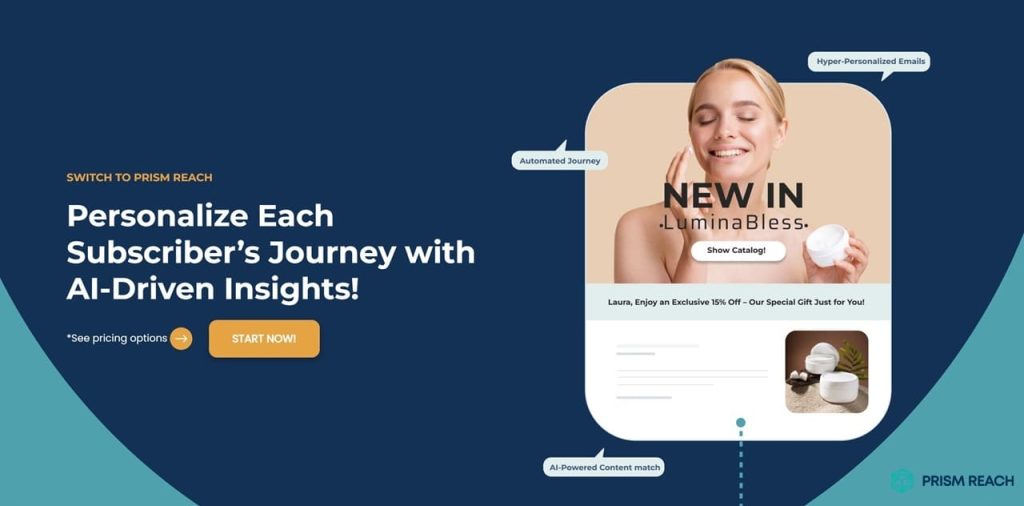
Benefits of Using Prism Reach in Curated Content Marketing
Integrating advanced tools like Prism Reach into your curated content strategies can significantly amplify their effectiveness. Prism Reach offers a suite of features specifically designed to enhance personalization, streamline content management, and provide actionable insights that drive better marketing outcomes. Here are three key benefits of using Prism Reach in curated content marketing:
1. Enhanced Personalization Through AI
Prism Reach utilizes sophisticated AI algorithms to create detailed user avatars based on subscriber behavior and preferences. This level of personalization is crucial for effectively reaching and engaging diverse audiences.
- Tailored Content: AI-driven personalization ensures that each subscriber receives content that is relevant to their unique preferences and interests.
- Behavioral Insights: By analyzing patterns in subscriber behavior, Prism Reach can predict future actions and tailor marketing messages accordingly, increasing the likelihood of positive engagement.
- Cultural Sensitivity: Personalized content respects and reflects the cultural nuances of different demographic groups, fostering a deeper connection with diverse audiences.
Example: A global apparel brand uses Prism Reach to segment its email list based on cultural preferences and purchase history. The AI personalizes each email with culturally relevant product recommendations and messaging, resulting in higher open and conversion rates across diverse markets.
2. Streamlined Content Management
Prism Reach’s ability to automate content discovery, categorization, and distribution significantly reduces the time and effort required to manage curated content. This streamlined approach ensures consistency and efficiency in your content marketing efforts.
- Automated Discovery: Prism Reach leverages AI to continuously scan and identify relevant content from a variety of sources, ensuring your curated content is always up-to-date.
- Content Categorization: The platform automatically organizes content into relevant categories, making it easy to create structured and thematic newsletters.
- Seamless Distribution: Prism Reach integrates with your existing email marketing systems to automate the distribution of curated content, ensuring timely delivery to your subscribers.
Example: A financial services firm uses Prism Reach to automate the curation of the latest market reports, investment tips, and industry news. This automation allows their marketing team to focus on strategic initiatives while ensuring their email newsletters are consistently packed with valuable and relevant content.
3. Improved Engagement and Conversion Rates
By delivering highly relevant and personalized curated content, Prism Reach helps boost engagement and conversion rates. Subscribers are more likely to interact with content that resonates with their interests and needs, leading to increased loyalty and revenue growth.
- Higher Open Rates: Personalized subject lines and content tailored to individual preferences can significantly increase email open rates.
- Increased Click-Through Rates: Relevant content encourages subscribers to click through to your website or landing pages, driving traffic and potential conversions.
- Enhanced Customer Loyalty: Consistently providing valuable curated content fosters trust and loyalty, making subscribers more likely to stay engaged and convert over time.
Example: An online education platform uses Prism Reach to deliver curated content tailored to each student’s learning path. By providing relevant articles, course recommendations, and success stories, they achieve higher engagement rates and an increase in course enrollments.
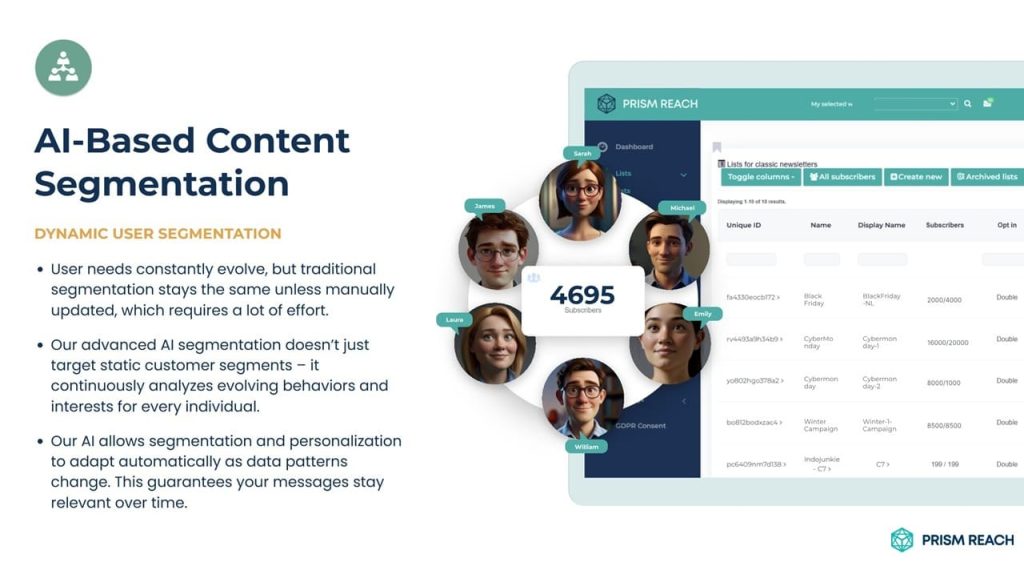
Practical Tips for Effective Curated Content in Email Marketing
To effectively integrate curated content into your email marketing strategy, consider the following practical tips. These strategies will help ensure that your campaigns are engaging, relevant, and impactful:
1. Upskill and Reskill
- Continuous Learning: Invest in training programs and courses to develop AI and data analytics skills.
- Certifications: Obtain certifications in AI-driven marketing tools and platforms like Prism Reach.
- Cross-Functional Skills: Develop skills that bridge marketing and technology, such as understanding AI algorithms and data interpretation.
2. Foster a Collaborative Culture
- Team Integration: Encourage collaboration between creative teams and data analysts to leverage AI insights effectively.
- Open Communication: Promote open communication about AI tools and their benefits within the organization.
- Shared Goals: Align team goals to incorporate AI-driven objectives alongside traditional marketing targets.
3. Prioritize Ethical AI Use
- Transparency: Be transparent with customers about how their data is being used and the role of AI in marketing interactions.
- Bias Mitigation: Regularly audit AI algorithms to ensure they do not perpetuate biases or unfair practices.
- Data Privacy: Adhere to data privacy regulations and implement robust data protection measures.
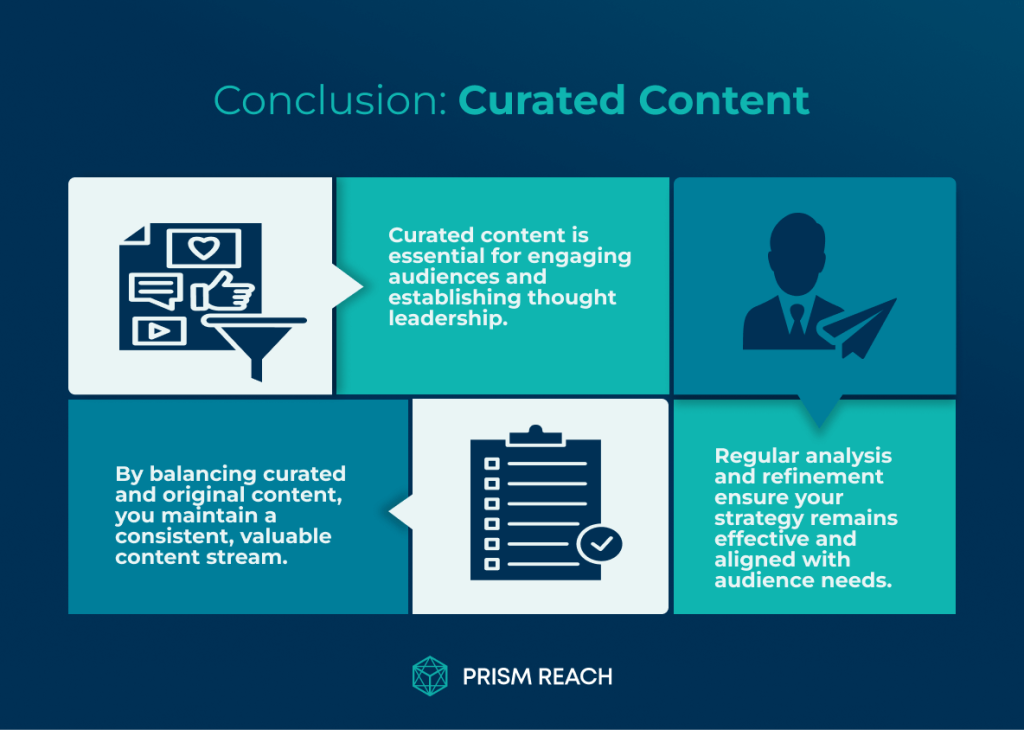
Conclusion
Curated content is a powerful tool for engaging your audience, building brand authority, and driving growth. By carefully selecting and sharing high-quality content, adding your own perspective, and leveraging multiple channels, you can establish yourself as a trusted resource in your industry.
Integrating advanced tools like Prism Reach further amplifies these strategies by providing enhanced personalization through AI, streamlined content management, and comprehensive performance monitoring. Prism Reach empowers businesses to create highly personalized and culturally relevant email marketing experiences that resonate with individual subscribers, leading to higher engagement, loyalty, and revenue growth.
Remember to continuously analyze and refine your curation strategy based on audience feedback and performance data. Stay up-to-date with the latest trends and best practices in your industry, and don’t be afraid to experiment with new tactics and formats to keep your audience engaged.
If you’re ready to take your email marketing to the next level, visit our website at https://prismreach.ai/ to learn more about how Prism Reach can help you achieve your goals. Start delivering the right content to the right people at the right time, and watch your engagement and revenue soar.